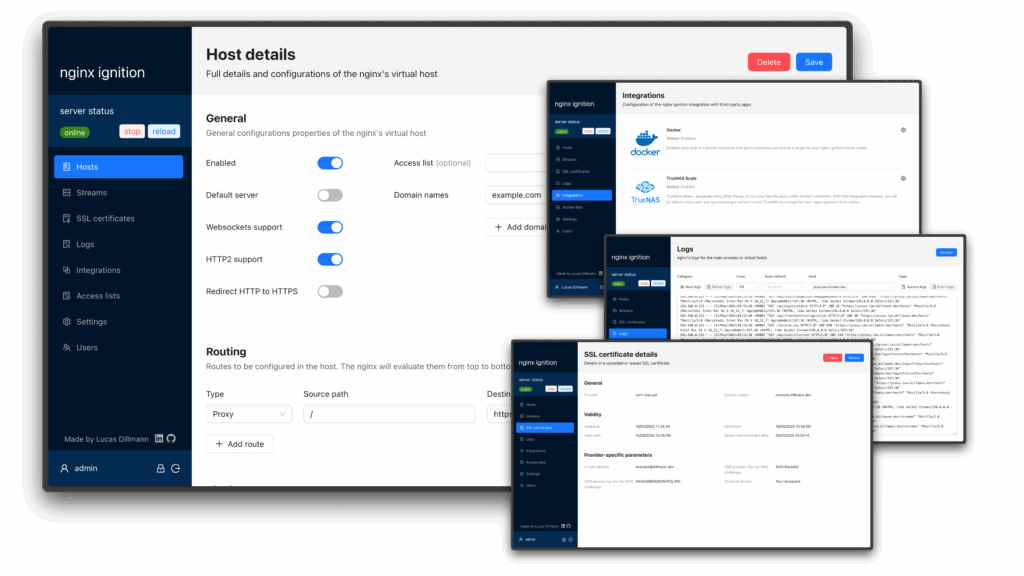Introduction: Simplifying Nginx Configuration with Visual Interface

Managing nginx configurations can be a daunting task, especially for developers who prefer visual interfaces over manual configuration file editing. Nginx Ignition emerges as a game-changing solution, providing an intuitive web-based interface for nginx server management. This comprehensive guide explores how this powerful tool can transform your nginx administration experience.
What is Nginx Ignition?
Nginx Ignition is an open-source user interface designed specifically for the nginx web server. Created by Lucas Dillmann, this innovative tool targets developers and system administrators who want to avoid the complexity of manually managing nginx configuration files while maintaining full control over their web server setup.
The project, available on GitHub, aims to provide an intuitive and powerful way to configure and run nginx without compromising on functionality or security.
Key Features and Capabilities
Virtual Host Management
- Multiple nginx virtual hosts with customizable domains, routes, and port bindings
- Flexible routing options including proxy configuration, redirections, and static file serving
- Support for custom JavaScript and Lua code execution
Stream Proxying
- Advanced TCP/UDP proxying capabilities for raw socket traffic
- Domain-based routing using SNI from TLS protocol
- Circuit breakers and weighted load balancing
- Unix socket support for enhanced performance
SSL/TLS Certificate Management
- Automated Let’s Encrypt integration for free SSL certificates
- Self-signed certificate generation
- Custom certificate upload support
- Automatic certificate renewal functionality
Access Control and Security
- Multi-user support with attribute-based access control (ABAC)
- Access lists with basic authentication
- Source IP address filtering
- Comprehensive logging with automatic rotation
Integration Capabilities
- Native Docker integration for container-based deployments
- TrueNAS Scale compatibility
- PostgreSQL database support for production environments
Installation and Setup Guide
Prerequisites
Before installing nginx ignition, ensure you have Docker installed on your system. For optimal performance, we recommend using a reliable VPS hosting solution like UnixHost VPS Linux servers, which provide the perfect environment for running containerized applications.
Quick Installation
docker run -p8090:8090 -p80:80 dillmann/nginx-ignitionAfter deployment, access the web interface at http://serverip:8090. The application will guide you through the initial user creation process.
Production Configuration
For production deployments, configure PostgreSQL as the backend database instead of the default SQLite:
docker run -e DATABASE_URL=postgresql://user:password@host:port/database \
-p8090:8090 -p80:80 dillmann/nginx-ignitionConfiguration Best Practices
Server Optimization
- Configure appropriate maximum body/upload sizes
- Set optimal timeout values for your use case
- Enable appropriate logging levels
- Disable server tokens for security
Security Considerations
- Implement strong access control policies
- Use SSL/TLS certificates for all public-facing services
- Configure proper firewall rules
- Regular security updates and monitoring
Performance Tuning
- Optimize worker processes based on CPU cores
- Configure appropriate connection limits
- Enable gzip compression
- Implement caching strategies
Use Cases and Scenarios
Development Environment
Perfect for developers who need quick nginx configuration for:
- Local development projects
- API gateway setup
- Microservices routing
- SSL termination
Production Deployments
Suitable for production environments requiring:
- Multiple virtual hosts management
- Load balancing configuration
- SSL certificate automation
- Access control implementation
Container Orchestration
Ideal for containerized environments with:
- Docker integration
- Service discovery
- Dynamic configuration updates
- Health check implementation
Why Choose VPS Hosting for Nginx Ignition?
When deploying nginx ignition in production, choosing the right hosting environment is crucial. UnixHost VPS Linux servers offer several advantages:
- Dedicated resources ensuring consistent performance
- Root access for complete nginx ignition configuration control
- Scalable infrastructure to handle growing traffic demands
- 24/7 technical support for deployment assistance
- High-speed SSD storage for optimal database performance
Advanced Configuration Tips
Database Optimization
- Use PostgreSQL for production deployments
- Implement regular backup strategies
- Monitor database performance metrics
- Configure appropriate connection pooling
Monitoring and Logging
- Enable comprehensive access and error logging
- Implement log rotation policies
- Set up monitoring alerts
- Use centralized logging solutions
Backup and Recovery
- Regular configuration backups
- Database backup automation
- Disaster recovery planning
- Version control for configuration changes
Troubleshooting Common Issues
Connection Problems
- Verify port bindings and firewall settings
- Check Docker container status
- Validate network configuration
- Review security group settings
Performance Issues
- Monitor resource usage
- Optimize database queries
- Check disk I/O performance
- Analyze network latency
Configuration Errors
- Validate nginx syntax
- Check certificate configurations
- Review access control settings
- Monitor application logs
Migration and Upgrades
When upgrading from version 1.x to 2.0.0, follow the official migration guide to ensure data integrity and configuration preservation. Always test upgrades in a staging environment before production deployment.
Community and Support
The nginx ignition project maintains active community support through:
- GitHub issues and pull requests
- Documentation updates
- Feature requests and feedback
- Community-driven improvements
Conclusion
Nginx Ignition represents a significant advancement in web server management, offering a perfect balance between ease of use and powerful functionality. Whether you’re a developer setting up local environments or a system administrator managing production infrastructure, this tool provides the flexibility and control needed for modern web applications.
For optimal deployment experience, consider using professional VPS hosting solutions like UnixHost VPS Linux to ensure your nginx ignition setup runs smoothly and efficiently.